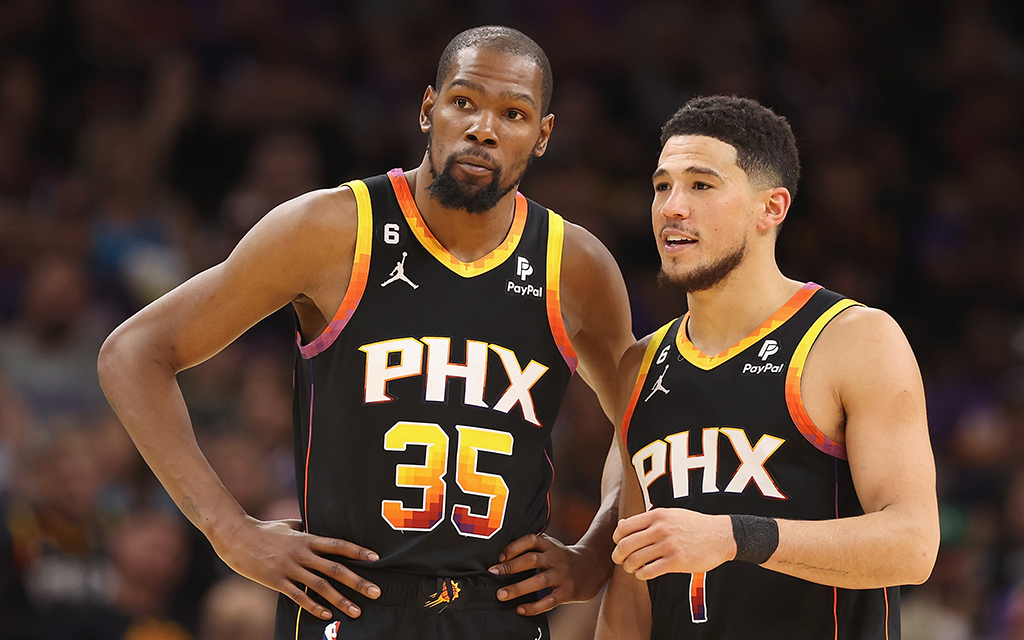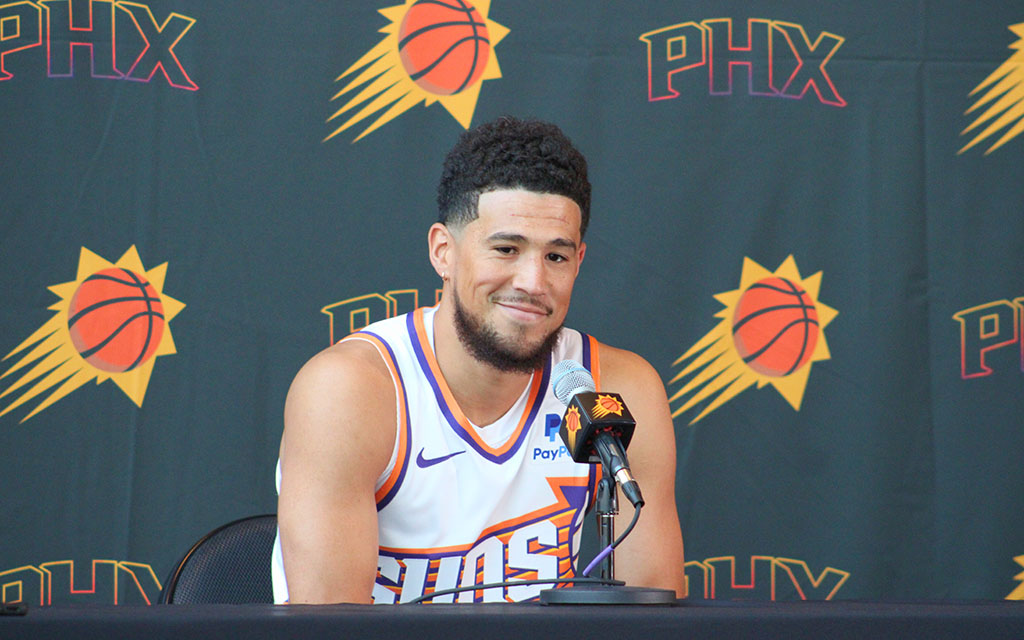
The Phoenix Suns will need to outline a strategy for managing the workload of Kevin Durant, left, Devin Booker and Bradley Beal under the NBA’s new load management policy. (Photo by Christian Petersen/Getty Images)
PHOENIX – Kevin Durant was all smiles at his first Phoenix Suns Media Day, until asked about the NBA’s new load management policy. After 15 seasons and several injuries, the superstar kept his response short and to the point.
“The NBA (is) going to do what they (are) going to do,” Durant said. “I guess we just got to abide by it to be honest. It is what it is.”
In an age when injury prevention reigns supreme, the demanding 82-game regular season has driven NBA teams to seek innovative strategies to ensure its top players are in peak condition when the playoffs arrive.
The concept of load management, which originated in the early 2010s, is now embarking on a new phase as the league introduces a policy designed to keep the marquee players on the court.
The new policy minimizes multiple star player absences in the same game, prioritizes national television and in-season tournament games, improves fan and public perception and promotes compliance via stricter rules and higher penalties. Players who meet the criteria of being All-NBA or an All-Star in the previous three seasons will be subject to these rules.
The big three in Phoenix – Durant, Devin Booker and Bradley Beal – find themselves under the spotlight, as they are now subject to the rules.
Unlike Durant, Beal and Booker were more receptive to the announcement.
“We got to go play,” Beal said. “I understand it from the league perspective. I understand our fight for players as well.”
Booker added, “I want to play every game that I’m healthy.”
The San Antonio Spurs, led by coach Gregg Popovich, were pioneers of limiting the wear and tear on their star players . They made headlines in 2012 by resting veteran stars Tim Duncan, Tony Parker and Manu Ginobili during a nationally televised game against Miami, incurring a hefty $250,000 fine.
On Sept. 13, the NBA Board of Governors unanimously voted to approve the Player Participation Policy in an attempt to address the issue. The decision was met with optimism and skepticism as the NBA ventures on a journey to strike a delicate balance between player health and competitive spirit.
“It’s actually a shame that the policy even needs to be implemented in the first place,” three-time NBA champion Scott Williams said. “We are warriors, gladiators, performers. When you’re given that opportunity to carry that mantle of the NBA, you go out there and you do your job.”
Williams’ sentiment resonates with many players from his era, the 1990s and early 2000s, who held the belief that the sport’s core values lay in dedication and unwavering commitment. Playing through injuries was a testament to their love for the game and loyalty to their fans. Having experienced championship glory alongside Michael Jordan, the seasoned vet understood what it took to win.
“I go out there and treat every game like it might have been the last opportunity to ever pull on an NBA jersey and strap up my high tops to go out there and try to perform,” Williams said. “To casually toss that to the side for an opportunity to rest my body is not something that ever would have crossed my mind.”
However, the landscape of the NBA has evolved substantially over time, driven by advancements in sports science and analytics. Nowadays, teams have access to data highlighting the correlation between player rest and a reduced risk of injuries.
When it comes to their star players, athletic trainers often exercise caution. Modern technological breakthroughs, such as GPS, track every facet of a player’s activity during games or practice sessions. This ability to analyze such data and potentially prevent severe injuries represents a capability that the league lacked in earlier years.
NBA commissioner Adam Silver emphasized that the science behind player rest is “inconclusive,” highlighting the complexity of the problem. Silver made it clear that the policy does not intend to eliminate rest but aims to address the most egregious examples of multiple star players being healthy and sitting out simultaneously.
“There’s no definite causation that’s been found,” Mike Vorkunov, national NBA reporter for The Athletic, said. “I think a lot of the times when players are asked to sit is driven by teams more so than the players themselves asking to sit out. For me, I’d like to see some hard evidence.”
Williams added, “All I know is if you’re hurt, you play. If you’re injured, you sit out. There’s a difference between being hurt and injured. An injury will prevent you from getting on the floor. There’s no doubt about that.”
A changed philosophy in the NBA. Teams do not want to risk their players if they’re not 100% healthy – potentially sacrificing a win. A commonly used strategy: playing players on a minutes-restriction. Having the player available for close game situations while monitoring the workload.
“Building on its different rule changes over the last year to try to get players to play more often,” Vorkunov said. The league has adjusted requirements for major end-of-season awards to encourage players to play more games – must play 65 games to be eligible for Most Valuable Player, Defensive Player of the Year, Most Improved, All-NBA and All-Defensive teams.
It’s a business. Athletes have shown the willingness to decide what’s best for their careers. Time and time again, we’ve seen disgruntled players request trades or hold out for a new contract. Everybody’s situation is different.
“Who am I to tell them to play if you’re 60% and end up going out there and do something worse to yourself and jeopardizing a contract,” Booker said.
Data indicates that the NBA had seen a reduction in back-to-back games over the years, from an average of 19.1 in the 2012-13 season to 13.3 in 2022-23, according to ESPN. The Suns are scheduled to play 14 back-to-backs in the upcoming season, two more than last season. Phoenix has the third most nationally televised games (37) this season.
Much like the 2012 incident involving the Spurs, under the league’s new rules, they have established a permanent fine system. Starting with a $100,000 penalty for initial violations, it increases to $250,000 for repeated infractions and costs an additional $1 million for each subsequent offense.
“We’re all operating under some level of trust,” said Jody Oehler, host of ‘The Drive’ on Fox Sports 910 Phoenix. “I think NBA teams are probably not going to lose sight if they want to win a championship. So I would expect there to be some positive benefit to it, but I don’t think it eliminates the problem.”
When the NBA schedule is released, fans eagerly begin making plans to watch their favorite teams and players in action. The excitement truly kicks off once they secure their tickets, with flight and hotel reservations soon to follow. However, nothing is promised until game day arrives.
Thirty minutes before tipoff, teams announce starting lineups and inactives. Fans are often disappointed when they arrive at the arena and find out their favorite player is not playing.
“I think the one thing you can’t mess with as a league is the trust between your fan base and your organization,” Oehler said.
From a business standpoint, an increase in the frequency of participation by top players is expected to result in improved ratings and higher revenue. “More visibility leads to better business,” Vorkunov said.
Not only does the availability of players enhance the on-court product, but the league is also targeting a lucrative media rights agreement after the conclusion of the 2024-2025 season. Establishing clear guidelines will only bolster the association’s position during negotiations.
New Suns coach Frank Vogel has learned different lessons at every stop in his 19 years in the league. “I cut my teeth at Indiana as a head coach,” he said. “I learned to evolve my system in Orlando. I learned to work with elite stars in LA.”
Vogel, who has worked with an aging LeBron James and an injury-prone Anthony Davis during his tenure with the Los Angeles Lakers, is well-positioned to handle this challenge. Vogel’s ability to manage workloads and demand defensive intensity was a big reason for their championship run in 2020.
How will Phoenix manage its three stars?
“This is a question that three years ago nobody would have ever thought about the Suns, and now it kind of feels like the Suns rule because they’ve got three stars,” Oehler said.
It’s a good problem for teams with championship aspirations.
After enduring a tough decade in the 2010s, the Suns find themselves facing a new challenge amid three straight playoff runs and a finals appearance. This newfound success also brings the task of effectively managing the workload of their trio of stars, a concern shared by fans in the Valley.
Vogel outlined his approach to the regular season, emphasizing a cautious mindset: “We’ll be smart in everything we do with what we’re asking them to do. Both from a workload standpoint with practice, off days and games throughout the course of the year.”
With a revamped roster, building team chemistry stands as a top priority. Vogel stressed the importance of willingness and selflessness as essential qualities for championship success.
Considering the team’s recent overhaul, the Suns will undoubtedly benefit from extra practice sessions on the court. The team will have to focus on building chemistry early on with the new system and roster.
“I don’t think the Suns were going to abuse this player load management before this rule, but I think the rule basically ensures that the Suns in the regular season are going to have to get all the reps with as many of these guys on the floor,” Oehler said.

